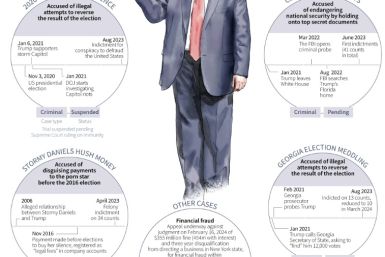Samsung remains smartphone market leader; Apple shipments slightly dip while Windows Phones continue to plummet

Samsung is still the world’s number one smartphone vendor, according to new data. The Galaxy phone maker increased its market share hold during this year’s first quarter from the previous year’s last. Its chief rival, Apple, has taken a tumble while Oppo has steadily improved.
Mobile phone giants have reportedly shipped an estimated 344.3 million units of smartphones around the world between January and March of this year. Despite the sluggish market, the demand for such mobile devices still remains strong especially since OEM flagships are still very much sought after.
Samsung remains to be the world’s top smartphone brand despite a zero percent year over year growth in Q1. Global market intelligence provider IDC notes that the discounted Galaxy S7 models and the company’s portfolio of more affordable handsets significantly boosted its market share lead. The new Galaxy S8 variants have likewise regained consumer trust after the Note 7 debacle.
Apple, meanwhile, saw its shipments drop from Q1 2016’s 51.2 million units to this year’s 50.7 million. The California-based tech titan is currently working on its tenth anniversary iPhone, which is reportedly the first to include an OLED display along with a bunch of new features. Huawei remains at the third spot while fourth placer Oppo is steadily improving its numbers thanks to stronger international market growth.
In the worldwide mobile OS market share, Android is understandably in control. The Google-developed operating system currently has 85 percent of the market, slightly up from last year’s 83.4 percent. Apple marginally loosened its grip with its 14.7 percent hold during this year’s first quarter, which is slightly down compared to Q1 2016’s 15.4 percent and last year’s Q4 share of 18.2 percent.
Windows Phone shipments, meanwhile, continue to plummet. This is due to lack of new hardware partners, developer support and the lack of interest for the platform, according to IDC. The future doesn’t look good for Microsoft’s mobile division as its unit shipments are projected to drop to just 1.1 million this year, an 80.9 percent plunge.
Worldwide smartphone company market share (in unit shipments)
- Samsung: Q1 2016: 23.8% | Q2 2016: 22.7% | Q3 2016: 20.9% | Q4 2016: 18.0% | Q1 2017: 23.3%
- Apple: Q1 2016: 15.4% | Q2 2016: 11.7% | Q3 2016: 12.5% | Q4 2016: 18.2% | Q1 2017: 14.7%
- Huawei: Q1 2016: 8.4% | Q2 2016: 9.3%| Q3 2016: 9.3% | Q4 2016: 10.5% | Q1 2017: 10.0%
- Oppo: Q1 2016: 5.9% | Q2 2016: 6.6% | Q3 2016: 7.1% | Q4 2016: 7.3% | Q1 2017: 7.5%
- Vivo: Q1 2016: 4.4% | Q2 2016: 4.8% | Q3 2016: 5.9% | Q4 2016: 5.7% | Q1 2017: 5.5%
- Others: Q1 2016: 42.1% | Q2 2016: 45.0% | Q3 2016: 44.3% | Q4 2016: 40.2% | Q1 2017: 39.0%
Worldwide smartphone OS market share (in unit shipments)
- Android: Q1 2016: 83.4% | Q2 2016: 87.6% | Q3 2016: 86.8% | Q4 2016: 81.4% | Q1 2017: 85.0%
- iOS: Q1 2016: 15.4% | Q2 2016: 11.7% | Q3 2016: 12.5% | Q4 2016: 18.2% | Q1 2017: 14.7%
- Windows: Q1 2016: 0.8% | Q2 2016: 0.4% | Q3 2016: 0.3% | Q4 2016: 0.2% | Q1 2017: 0.1%
- Others: Q1 2016: 0.4% | Q2 2016: 0.3% | Q3 2016: 0.4% | Q4 2016: 0.2% | Q1 2017: 0.1%
MORE MOBILE TECH NEWS:
Nokia 105 & Nokia 130 (2017 models): Specs, price and launch details
OnePlus 5 vs HTC U11: Battery performance review and comparison






